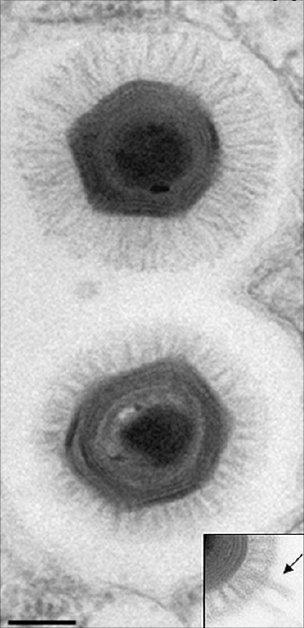Ocean trawl reveals 'megavirus'
- Published

Hair-like structures can be seen of the outside of the Mimivirus (top) and Megavirus (bottom) particles
The largest virus yet discovered has been isolated from ocean water pulled up off the coast of Chile.
Called Megavirus chilensis, it is 10 to 20 times wider than the average virus.
It just beats the previous record holder, Mimivirus, which was found in a water cooling tower in the UK in 1992.
Scientists tell the journal PNAS, external that Megavirus probably infects amoebas, single-celled organisms that are floating free in the sea.
The particle measures about 0.7 micrometres (thousandths of a millimetre) in diameter.
"It is bigger than some bacteria," explained Prof Jean-Michel Claverie, from Aix-Marseille University, Marseille, France.
"You don't need an electron microscope to see it; you can see it with an ordinary light microscope," he told BBC News.
Viruses cannot copy themselves; they need to invade a host cell if they want to replicate.
Like Mimivirus, Megavirus has hair-like structures, or fibrils, on the exterior of its shell, or capsid, that probably attract unsuspecting amoebas looking to prey on bacteria displaying similar features.
A study of the giant virus's DNA shows it to have more than a thousand genes, the biochemical instructions it uses to build the systems it requires to replicate once inside its host.
In the lab experiments conducted by Professor Claverie and colleagues, in which they infected fresh-water amoebas, Megavirus was seen to construct large trojan organelles - the "cells within cells" that would produce new viruses to infect other amoebas.
"Everything is initiated from a single particle, and then grows and grows to become this virion factory," explained Prof Claverie. "That's why it needs all these genes."
Megavirus was found off the coast of Las Cruces, central Chile. It was recovered as part of a general trawl in the ocean for biology of interest.
"This is a new way of doing virology," said Prof Claverie.
Carl Zimmer, author of A Planet of Viruses: "Very large and very strange and very interesting"
"Previously, we only discovered viruses because they caused disease in humans, or animals and plants. But now we are initiating what might be called environmental virology and we are looking for viruses everywhere.
"You just go to lakes, seas and oceans and pick up the water, and then you filter it, and try to rescue the virus by co-cultivating it with some potential host."
More generally, there is interest in ocean viruses because they have a major influence on populations of plankton, the microscopic organisms that form the base of many marine food chains. And when they kill plankton, viruses are also helping to regulate the planet's geochemical cycles as the dead organisms sink into the deep, locking away their carbon for aeons.
Prof Claverie said the megavirus would not be hazardous to humans.